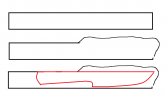- Joined
- May 31, 2016
- Messages
- 485
Long story short, a buddy wants a small utility/hunter made from an old file (fine, single cut) his grandfather passed on (nicholson, old, through hardened, I am assuming it is 1095/w2/w1 on the high carbon end), spark test looks like it is very carbon rich. I will HT like 1095 or w1/2.
Anyway, I have no desire to give the man a 4" or so blade that is nigh on 3/8" thick, so I am curious if anyone can think of/knows a way to preserve a visual record of the serrations while still getting something that has geometry, distal taper, etc. appropriate to its size and function.
The only thing I can think that may work is acid etching/wire brushing off any oxidation, and forging a sanmai with 1018 or similar cladding. The final etch may show the saw teeth, but then it is a fine serration file and I have little confidence at all that the teeth will be visible at all in the final knife. Throwing it into a canister seems to pose a similar problem.
I am guessing that there is no practical solution, but just wanted to see if anybody had any ideas.
Anyway, I have no desire to give the man a 4" or so blade that is nigh on 3/8" thick, so I am curious if anyone can think of/knows a way to preserve a visual record of the serrations while still getting something that has geometry, distal taper, etc. appropriate to its size and function.
The only thing I can think that may work is acid etching/wire brushing off any oxidation, and forging a sanmai with 1018 or similar cladding. The final etch may show the saw teeth, but then it is a fine serration file and I have little confidence at all that the teeth will be visible at all in the final knife. Throwing it into a canister seems to pose a similar problem.
I am guessing that there is no practical solution, but just wanted to see if anybody had any ideas.





